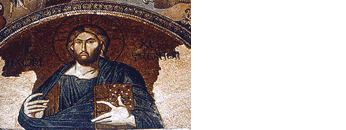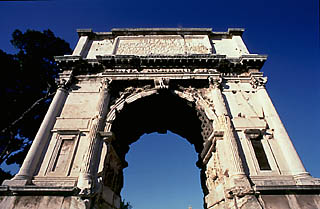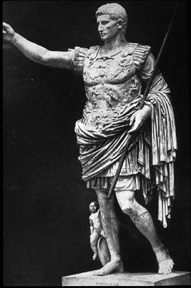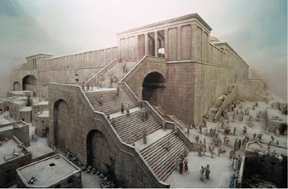
|
|
|
|
| Class
Prep |
|
|
|
Roman Political Theology & Jewish Theological Politics
 Some
60 years before Jesus' birth, the political situation in the Near East began to
change dramatically. Two successors of the Jewish Hasmonean dynasty competed for the throne and dragged the
country into civil war, and the ambitious Roman general Pompey seized the opportunity
to move into the region and claim it as one of Rome's provinces. Rome had a few
civil wars of its own to deal with for the next few decades, but it found a steady
ally in the son of an Idumean convert to Judaism, Herod, whom the Roman Senate declared "King
of the Jews" in 40 BCE. After securing his territory and consolidating control
three years later, Herod settled in to a 33-year reign in Jerusalem under which
the country expanded dramatically, prospered economically, and enjoyed unparalleled
support from Rome. Some
60 years before Jesus' birth, the political situation in the Near East began to
change dramatically. Two successors of the Jewish Hasmonean dynasty competed for the throne and dragged the
country into civil war, and the ambitious Roman general Pompey seized the opportunity
to move into the region and claim it as one of Rome's provinces. Rome had a few
civil wars of its own to deal with for the next few decades, but it found a steady
ally in the son of an Idumean convert to Judaism, Herod, whom the Roman Senate declared "King
of the Jews" in 40 BCE. After securing his territory and consolidating control
three years later, Herod settled in to a 33-year reign in Jerusalem under which
the country expanded dramatically, prospered economically, and enjoyed unparalleled
support from Rome.-

- Today's
readings introduce you to the political situation in Rome and its impact on the
territory that would come to be known as Roman Palestine, the region where Jesus
lived. In class, we'll focus on the basic chronology of imperial domination and
the specifics of Roman governance in Judea, Samaria, and the Galilee. In particular,
we will need to discuss the shift that occurred in the Roman Republic in the first
century BCE, as Rome's own internal political system changed from a republican
to an imperial style of rule, first under
Julius Caesar and then under his adopted nephew, Octavian (pictured
to the left). It is Octavian who solidified the new form of imperial government
for his dynasty, and his imperial propaganda shaped the presentation of Jesus
in the New Testament. So as you read the material in HJFD, study the historical
timeline and the various impacts Rome had in Jewish lands.
-
- The secondary reading also introduces you to Judaism in Jesus' time. Actually, it would be more accurate to speak of "Judaisms," since there was no single way of practicing Judaism in antiquity. There were certainly central beliefs shared by almost all groups, such as the belief in one God,
the central importance of the Torah (the first five books of the Jewish scriptures),
and the role of the sacrificial system in the Jerusalem Temple on which so much
of the Torah focuses (the picture below is an artist's reconstruction of Herod's expanded Temple Mount from the southwest
corner). But beyond those shared beliefs, there were several differences between groups that were exacerbated by the presence of Rome.
-
 The reading for today includes
the first-century Jewish historian Josephus' account of three leading "philosophies"
or groups in Jewish society from the time of the Hasmonean dynasty to the First
Jewish Revolt. (He throws in a fourth "philosophy," the Zealots, but
treats them as a somewhat separate case.) The secondary reading in The Historical
Jesus for Dummies summarizes some of the salient features of each group. As
you read, chart for yourself the four groups and their major features. Categorize
these features as best you can: economic/political status, religious beliefs (what
scriptures they read, who their authorized interpreters were, what traditions
they added to the scriptures). The other new material in this chapter to focus
on is the background on messianic beliefs. Study this carefully, along with the handout passed out in class on "Models of the Messiah." The reading for today includes
the first-century Jewish historian Josephus' account of three leading "philosophies"
or groups in Jewish society from the time of the Hasmonean dynasty to the First
Jewish Revolt. (He throws in a fourth "philosophy," the Zealots, but
treats them as a somewhat separate case.) The secondary reading in The Historical
Jesus for Dummies summarizes some of the salient features of each group. As
you read, chart for yourself the four groups and their major features. Categorize
these features as best you can: economic/political status, religious beliefs (what
scriptures they read, who their authorized interpreters were, what traditions
they added to the scriptures). The other new material in this chapter to focus
on is the background on messianic beliefs. Study this carefully, along with the handout passed out in class on "Models of the Messiah." -
-
-
- Assigned Readings
-
-
| Primary: |
Josephus, War 2.8.2-14 (Camino) |
| Secondary: |
Murphy, HJFD 81-126 (Camino); Ehrman, Did Jesus Exist? 267-88 [top]; online class prep |
| Lecture Slides: |
Class 5a (pdf) |
-
-
- Presentations
-
-
-
-
- Further Reading
-
- Brunt, P. A. and Moore, J. M., eds. Res Gestae "Divi Augusti: The Achievements
of the Divine Augustus". New York: Oxford University Press,
1969.
-
- Hayes, John Haralson and Sara Mandell, eds. The Jewish People in Classical
Antiquity: From Alexander to Bar Kochba. Louisville: Westminster
John Knox, 1998.
-
- Marshak, Adam Kolman. The Many Faces of Herod the Great. Grand Rapids, Michigan: William B. Eerdmans, 2015.
-
- Millar, Fergus. The Roman Near East, 31 BC - AD 337. Cambridge,
Massachusetts: Harvard University Press, 1993.
-
- Netzer, Ehud. The Architecture of Herod the Great Builder. Grand Rapids, Michigan: Baker Academic, 2008; original Tübingen: Mohr Siebeck, 2006.
-
- Schäffer, Peter. History of the Jews in the Greco-Roman World: The Jews of
Palestine from Alexander the Great to the Arab Conquest. New York:
Routledge, 2003.
-
- Schwartz, Daniel R. "Composition and Sources in Antiquities 18: The Case of Pontius Pilate." In Making History: Josephus and Historical Method (ed. Zuleika Rodgers; Supplements to the Journal for the Study of Judaism 110; Boston: Brill, 2007) 125-46.
-
- Schwartz, Seth. Imperialism and Jewish Society: 200 B.C.E. to 640 C.E., Jews, Christians, and Muslims from the Ancient to the Modern World).
Princeton, New Jersey: Princeton University Press, 2002.
-
- Smallwood, E. Mary. The Jews Under Roman Rule from Pompey to Diocletian, SJLA. Leiden:
Brill, 1997; original 1981.
-
- Tacitus. The
Annals of Imperial Rome, trans. Michael Grant. Harmondsworth, England: Penguin
Classics, 1977.
-
- Zanker, Paul. The Power of Images in the Age of Augustus, trans. Alan Shapiro. Ann
Arbor, Michigan: University of Michigan Press, 1989.
-
-
- Links
-
- The
Roman Empire in the First Century - A PBS Series aired in 2006 (produced
by Margaret Koval and Lyn Goldfarb).
- Virtual
Rome - A digital reproduction of Rome at the peak of its power in 320
CE, hosted at the University of Virginia and launched in 2007.
- Internet
Ancient History Sourcebook: Rome - Primary texts from the Roman period,
along with links to other resources. Hosted at Fordham University.
- Virtual
Qumran - A 3D online reconstruction of the compound most likely used
as a center by the Essenes. Hosted at the UCLA Department of Near Eastern Languages
and Cultures.
- Judaism's
First Century Diversity - Shaye J. D. Cohen's essay on "Pharisees,
Sadducees, Essenes, and Just Plain Jews," from the 2000 PBS Frontline series,
From Jesus to Christ (produced by Marilyn Mellowes, WGBH Boston).
-
-
- Sources of Photographs
-
- Arch
of Titus, Rome (commemorating the Roman victory over the Judeans in the First
Jewish Revolt)
- Statue of Caesar Augustus
- Artist's reconstruction of the Second Temple (as expanded by Herod the Great), Bojan Brecelj/CORBIS,
BJ001371 (RM), CORBIS, online, http://pro.corbis.com/search/searchFrame.aspx.
-
-
|
|
|
|
|
